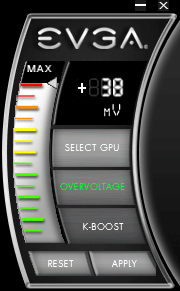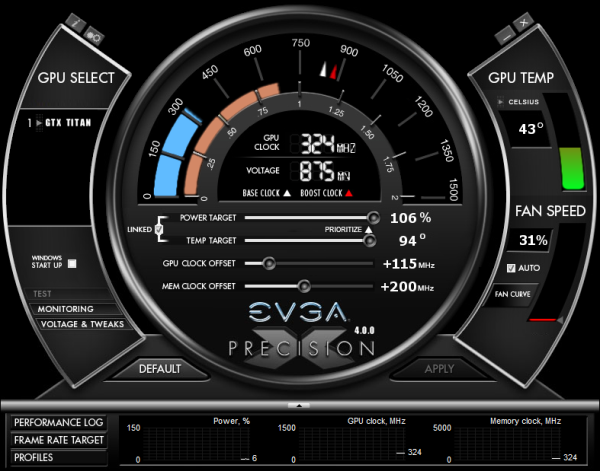NVIDIA’s GeForce GTX Titan Review, Part 2: Titan's Performance Unveiled
by Ryan Smith & Rahul Garg on February 21, 2013 9:00 AM ESTThe Final Word On Overclocking
Before we jump into our performance breakdown, I wanted to take a few minutes to write a bit of a feature follow-up to our overclocking coverage from Tuesday. Since we couldn’t reveal performance numbers at the time – and quite honestly we hadn’t even finished evaluating Titan – we couldn’t give you the complete story on Titan. So some clarification is in order.
On Tuesday we discussed how Titan reintroduces overvolting for NVIDIA products, but now with additional details from NVIDIA along with our own performance data we have the complete picture, and overclockers will want to pay close attention. NVIDIA may be reintroducing overvolting, but it may not be quite what many of us were first thinking.
First and foremost, Titan still has a hard TDP limit, just like GTX 680 cards. Titan cannot and will not cross this limit, as it’s built into the firmware of the card and essentially enforced by NVIDIA through their agreements with their partners. This TDP limit is 106% of Titan’s base TDP of 250W, or 265W. No matter what you throw at Titan or how you cool it, it will not let itself pull more than 265W sustained.
Compared to the GTX 680 this is both good news and bad news. The good news is that with NVIDIA having done away with the pesky concept of target power versus TDP, the entire process is much simpler; the power target will tell you exactly what the card will pull up to on a percentage basis, with no need to know about their separate power targets or their importance. Furthermore with the ability to focus just on just TDP, NVIDIA didn’t set their power limits on Titan nearly as conservatively as they did on GTX 680.
The bad news is that while GTX 680 shipped with a max power target of 132%, Titan is again only 106%. Once you do hit that TDP limit you only have 6% (15W) more to go, and that’s it. Titan essentially has more headroom out of the box, but it will have less headroom for making adjustments. So hardcore overclockers dreaming of slamming 400W through Titan will come away disappointed, though it goes without saying that Titan’s power delivery system was never designed for that in the first place. All indications are that NVIDIA built Titan’s power delivery system for around 265W, and that’s exactly what buyers will get.
Second, let’s talk about overvolting. What we didn’t realize on Tuesday but realize now is that overvolting as implemented in Titan is not overvolting in the traditional sense, and practically speaking I doubt too many hardcore overclockers will even recognize it as overvolting. What we mean by this is that overvolting was not implemented as a direct control system as it was on past generation cards, or even the NVIDIA-nixed cards like the MSI Lightning or EVGA Classified.
Overvolting is instead a set of two additional turbo clock bins, above and beyond Titan’s default top bin. On our sample the top bin is 1.1625v, which corresponds to a 992MHz core clock. Overvolting Titan to 1.2 means unlocking two more bins: 1006MHz @ 1.175v, and 1019MHz @ 1.2v. Or put another way, overvolting on Titan involves unlocking only another 27MHz in performance.

These two bins are in the strictest sense overvolting – NVIDIA doesn’t believe voltages over 1.1625v on Titan will meet their longevity standards, so using them is still very much going to reduce the lifespan of a Titan card – but it’s probably not the kind of direct control overvolting hardcore overclockers were expecting. The end result is that with Titan there’s simply no option to slap on another 0.05v – 0.1v in order to squeak out another 100MHz or so. You can trade longevity for the potential to get another 27MHz, but that’s it.
Ultimately, this means that overvolting as implemented on Titan cannot be used to improve the clockspeeds attainable through the use of the offset clock functionality NVIDIA provides. In the case of our sample it peters out after +115MHz offset without overvolting, and it peters out after +115MHz offset with overvolting. The only difference is that we gain access to a further 27MHz when we have the thermal and power headroom available to hit the necessary bins.
| GeForce GTX Titan Clockspeed Bins | |||
| Clockspeed | Voltage | ||
| 1019MHz | 1.2v | ||
| 1006MHz | 1.175v | ||
| 992MHz | 1.1625v | ||
| 979MHz | 1.15v | ||
| 966MHz | 1.137v | ||
| 953MHz | 1.125v | ||
| 940MHz | 1.112v | ||
| 927MHz | 1.1v | ||
| 914MHz | 1.087v | ||
| 901MHz | 1.075v | ||
| 888MHz | 1.062v | ||
| 875MHz | 1.05v | ||
| 862MHz | 1.037v | ||
| 849MHz | 1.025v | ||
| 836MHz | 1.012v | ||
Finally, as with the GTX 680 and GTX 690, NVIDIA will be keeping tight control over what Asus, EVGA, and their other partners release. Those partners will have the option to release Titan cards with factory overclocks and Titan cards with different coolers (i.e. water blocks), but they won’t be able to expose direct voltage control or ship parts with higher voltages. Nor for that matter will they be able to create Titan cards with significantly different designs (i.e. more VRM phases); every Titan card will be a variant on the reference design.
This is essentially no different than how the GTX 690 was handled, but I think it’s something that’s important to note before anyone with dreams of big overclocks throws down $999 on a Titan card. To be clear, GPU Boost 2.0 is a significant improvement in the entire power/thermal management process compared to GPU Boost 1.0, and this kind of control means that no one needs to be concerned with blowing up their video card (accidentally or otherwise), but it’s a system that comes with gains and losses. So overclockers will want to pay close attention to what they’re getting into with GPU Boost 2.0 and Titan, and what they can and cannot do with the card.











337 Comments
View All Comments
chizow - Friday, February 22, 2013 - link
Idiot...has the top end card cost 2x as much every time? Of course not!!! Or we'd be paying $100K for GPUs!!!CeriseCogburn - Saturday, February 23, 2013 - link
Stop being an IDIOT.What is the cost of the 7970 now, vs what I paid for it at release, you insane gasbag ?
You seem to have a brainfart embedded in your cranium, maybe you should go propose to Charlie D.
chizow - Saturday, February 23, 2013 - link
It's even cheaper than it was at launch, $380 vs. $550, which is the natural progression....parts at a certain performance level get CHEAPER as new parts are introduced to the market. That's called progress. Otherwise there would be NO INCENTIVE to *upgrade* (look this word up please, it has meaning).You will not pay the same money for the same performance unless the part breaks down, and semiconductors under normal usage have proven to be extremely venerable components. People expect progress, *more* performance at the same price points. People will not pay increasing prices for things that are not essential to life (like gas, food, shelter), this is called the price inelasticity of demand.
This is a basic lesson in business, marketing, and economics applied to the semiconductor/electronics industry. You obviously have no formal training in any of the above disciplines, so please stop commenting like a ranting and raving idiot about concepts you clearly do not understand.
CeriseCogburn - Saturday, February 23, 2013 - link
They're ALREADY SOLD OUT STUPID IDIOT THEORIST.LOL
The true loser, an idiot fool, wrong before he's done typing, the "education" is his brainwashed fried gourd Charlie D OWNZ.
chizow - Sunday, February 24, 2013 - link
And? There's going to be some demand for this card just as there was demand for the 690, it's just going to be much lower based on the price tag than previous high-end cards. I never claimed anything otherwise.I outlined the expectations, economics, and buying decisions in general for the tech industry and in general, they hold true. Just look around and you'll get plenty of confirmation where people (like me) who previously bought 1, 2, 3 of these $500-650 GPUs are opting to pass on a single Titanic at $1000.
Nvidia's introduction of an "ultra-premium" range is an unsustainable business model because it assumes Nvidia will be able to sustain this massive performance lead over AMD. Not to mention they will have a harder time justifying the price if their own next-gen offering isn't convincingly faster.
CeriseCogburn - Tuesday, February 26, 2013 - link
You're not the nVidia CEO nor their bean counter, you whacked out fool.You're the IDIOT that babbles out stupid concepts with words like "justifying", as you purport to be an nVidia marketing hired expert.
You're not. You're a disgruntled indoctrinated crybaby who can't move on with the times, living in a false past, and waiting for a future not here yet.
Oxford Guy - Thursday, February 21, 2013 - link
The article's first page has the word luxury appearing five times. The blurb, which I read prior to reading the article's first page has luxury appearing twice.That is 7 uses of the word in just a bit over one page.
Let me guess... it's a luxury product?
CeriseCogburn - Tuesday, February 26, 2013 - link
It's stupid if you ask me. But that's this place, not very nVidia friendly after their little didn't get the new 98xx fiasco, just like Tom's.A lot of these top tier cards are a luxury, not just the Titan, as one can get by with far less, the problem is, the $500 cards fail often at 1920x resolution, and this one perhaps can be said to have conquered just that, so here we have a "luxury product" that really can't do it's job entirely, or let's just say barely, maybe, as 1920X is not a luxury resolution.
Turn OFF and down SOME in game features, and that's generally, not just extreme case.
People are fools though, almost all the time. Thus we have this crazed "reviews" outlook distortion, and certainly no such thing as Never Settle.
We're ALWAYS settling when it comes to video card power.
araczynski - Thursday, February 21, 2013 - link
too bad there's not a single game benchmark in that whole article that I give 2 squirts about. throw in some RPG's please, like witcher/skyrim.Ryan Smith - Thursday, February 21, 2013 - link
We did test Skyrim only to ultimately pass on it for a benchmark. The problem with Skyrim (and RPGs in general) is that they're typically CPU limited. In this case our charts would be nothing but bar after bar at roughly 90fps, which wouldn't tell us anything meaningful about the GPU.